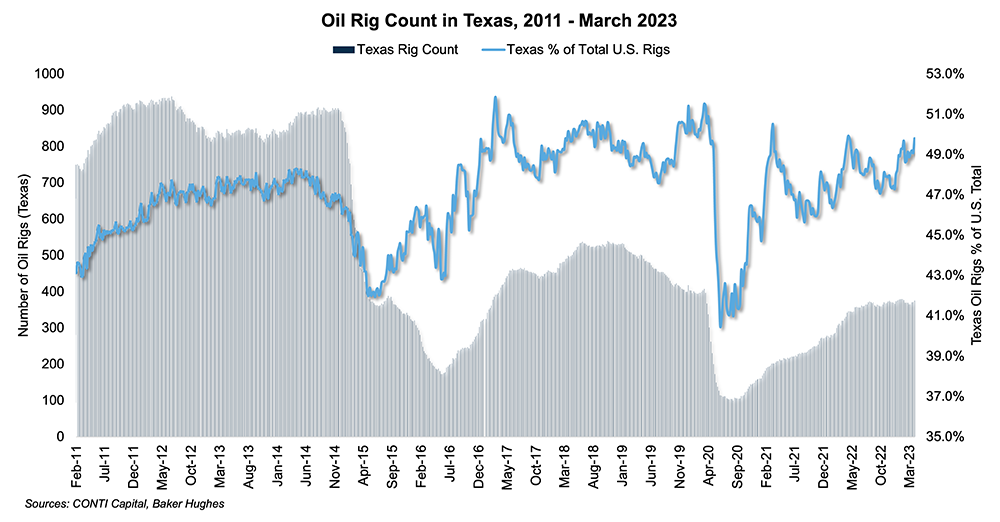
Texas and Oil: How the State’s Economic Engine Has Diversified
Over a century ago, the oil running beneath the Texas soil catapulted the state into economic prominence1, and this critical resource remains integral to the Texas economy today. As of December 2022, Texas oil fields produced upwards of 5,000 barrels per day2, by far the most of any U.S. state, and consistently Texas’ #1 export. Consequently, Texas’ natural wealth of oil has bolstered the economic power of the U.S. and established the state as a major force on a global scale. Yet the oil industry is prone to economic fluctuations, and this reality has helped push the state towards greater economic diversity. Today, Texas’ major metros demonstrate flourishing technology, manufacturing and finance sectors, to name just a few industries which buoy the state’s economy, as we will substantiate in this piece.
CONTI Capital’s approach to multifamily investment favors markets with flourishing industry clusters, as they tend to be associated with higher levels of productivity, innovation and a skilled workforce. Texas’ energy sector is one of the oldest industry clusters in the U.S., and although the oil and gas industry tends to move in line with oil prices, we believe the industry can be a critical component of a thriving regional economy.
Subscribe now for more CONTI insights
Over a century ago, the oil running beneath the Texas soil catapulted the state into economic prominence1, and this critical resource remains integral to the Texas economy today. As of December 2022, Texas oil fields produced upwards of 5,000 barrels per day2, by far the most of any U.S. state, and consistently Texas’ #1 export. Consequently, Texas’ natural wealth of oil has bolstered the economic power of the U.S. and established the state as a major force on a global scale. Yet the oil industry is prone to economic fluctuations, and this reality has helped push the state towards greater economic diversity. Today, Texas’ major metros demonstrate flourishing technology, manufacturing and finance sectors, to name just a few industries which buoy the state’s economy, as we will substantiate in this piece.
CONTI Capital’s approach to multifamily investment favors markets with flourishing industry clusters, as they tend to be associated with higher levels of productivity, innovation and a skilled workforce. Texas’ energy sector is one of the oldest industry clusters in the U.S., and although the oil and gas industry tends to move in line with oil prices, we believe the industry can be a critical component of a thriving regional economy.
Subscribe now for more CONTI insights
A Capricious Resource
Roughly 368 oil rigs around the state of Texas pull oil from the ground every day3, and this crude product is refined into something that powers much of the modern world. Oil’s global relevance makes it vulnerable to economic and geopolitical ups and downs. In 2014, for instance, various global pressures and a glut of supply caused oil prices to take a steep slide from about $108 per barrel in June of that year to roughly $44 in January of 20154, resulting in upwards of 80,000 industry job losses5.
More recently, consumers felt the pinch of rising gas prices in the earlier part of 2022, as Russia’s invasion of Ukraine compounded existing supply and pricing issues. Rising gas and energy prices were swept up in broad price inflation across the U.S. This is just the latest reminder that oil and energy prices are notoriously volatile.
Yet the oil and gas industry is also an economic boon to Texas, propelling not only trade and productivity, but generating billions of dollars in revenue and creating a multitude of high-paying jobs. Nearly 6,000 oil and gas companies operate within Texas6, including oil giants like Shell, ExxonMobile and ConocoPhillips, and these companies employ geoscientists, petroleum engineers and project managers who typically average upwards of six figures in annual salary7. This is significant to us, as high-paying jobs such as these correlate closely with demand for multifamily, and Class A multifamily in particular.

As the chart above illustrates, though the number of operational rigs in Texas has fallen notably over the last 12 years, Texas remains quite central to U.S. oil production generally. It’s also worth remarking upon that, while the number of working rigs in Texas has fallen, Texas’ barrel-per-day production has increased8, signifying the improvement of operational efficiencies.
All told, we feel the energy is an economic advantage for Texas. We believe this entrenched industry contributes a net positive to multifamily demand within the state.
Wide-Ranging Industries
The state’s economic prowess resides not just with its natural resources, but with its industrial diversity. Following a severe oil bust in the 1980s, Texas began a proactive effort to diversify away from the oil and gas industry and create a more balanced economy. The state government began to focus on enticing companies to put down roots in Texas and create jobs through various initiatives, funds and tax credits.
For instance, Texas also boasts a formidable and wide-ranging manufacturing sector, producing everything from chemicals to electronics to heavy machinery and generating hundreds of billions of dollars in revenue every year9. As of 2021, manufacturing accounted for more than 10% of the total U.S. manufacturing GDP10. We are especially interested in the rapidly growing advanced manufacturing sector, which makes use of cutting-edge technologies and has the potential to reinforce the Texas economy through our long-term outlook.
The manufacturing sector closely intertwines with the oil and gas industry, as well as another steadily growing Texas industry – technology. The Lone Star State has successfully cultivated several tech subsectors. Prominent among those is semiconductor manufacturing, which per our own analysis is conducive to long-term economic development. Texas Instruments and Samsung are two of the largest semiconductor manufacturers among many in the state. Semiconductor manufacturing companies generate six figure jobs in engineering, research and development and management11. Software development is another major tech subsector in Texas – companies like Adobe, Microsoft and Oracle have operations in Texas, creating more engineering and product development jobs. Texas is also home to a cluster of cybersecurity operations.
As we’ve mentioned, these sorts of steady, high-salary jobs correlate closely with demand for apartments. Within Texas, these jobs are largely focused in the major metros of Dallas, Austin and Houston, helping to boost all three of these markets into CONTI Capital’s Top 10 Markets for Multifamily Investment. Each of these markets has its particular strengths – a growing crowd of tech startups has found a home in Austin, and Dallas-Fort Worth boasts a well-established finance cluster, creating well-paid jobs in investment banking, commercial banking and asset management. Both markets have demonstrated robust inward migration, and the combination of high-salary job growth and increasing population make Austin and DFW stellar multifamily markets, in our view.
But when it comes to oil, no major metro can claim Houston’s crown. Houston as a metro is one of the biggest producers of oil in the world, exporting tens of billions of dollars’ worth of oil and gas, chemicals and petroleum products12. Though the volume of oil-related exports is down from its peak in the summer of 2022, when gas prices were so high, oil exports have surpassed pre-pandemic levels. However, the proportion of workers within the oil and gas sector isn’t proportionate to its output – only about 2% of Houston workers work within mining and logging13.
Houston’s economy has diversified remarkably within the last several years, nurturing its own tech and healthcare clusters. The Texas Medical Center, for example, employs more than 100,000 people, and healthcare services make up roughly 8% of jobs in Houston14. The growth in these sectors is helping to bolster Houston’s sizeable millennial population – a demographic that fits in well with our multifamily tenant profile.
Texas Metros and Their Multifamily Demand
Texas’ robust job creation levels both within and outside the energy sector continue to pull in above-average inward migration to its metro metropolitan areas. DFW, Austin and Houston still provide a cheaper cost of living than Gateway markets such as Los Angeles, San Jose and New York City, which helps pull talent away from the established tech nodes in those areas. This is a major contributor to the need for apartments. Though many major metros across the U.S. have seen an increase in the supply pipeline and a moderation in demand in recent quarters, metros like Dallas-Fort Worth are pulling in enough population growth to absorb new supply. All three of the markets we’ve mentioned demonstrate our preferred measures of long-term multifamily performance.
The oil that flows beneath earth remains a pillar of not only the Texas economy, but also identity, and reinforces the state’s performance as a multifamily market. But should the oil industry take a tumble similar to what we’ve seen historically, Texas’ economy is diversified and resilient enough to stay steady in uncertain times.
SOURCES
1 https://www.texasalmanac.com/articles/oil-and-texas-a-cultural-history
2 https://www.eia.gov/dnav/pet/hist/LeafHandler.ashx?n=PET&s=MCRFPTX2&f=M
3 https://rigcount.bakerhughes.com/na-rig-count
5 https://money.cnn.com/2015/09/03/investing/cheap-oil-job-cuts/
7 https://www.bls.gov/iag/tgs/iag211.htm
8 https://www.eia.gov/dnav/pet/hist/LeafHandler.ashx?n=PET&s=MCRFPTX2&f=M
9 https://www.nam.org/state-manufacturing-data/2022-texas-manufacturing-facts/
10 https://businessintexas.com/wp-content/uploads/2022/04/Snapshot_Manufacturing_Sept2021.pdf
11 https://www.bls.gov/oes/current/naics4_334400.htm
12 https://www.dallasfed.org/research/indicators/hou/2023/hou2303
13 https://www.dallasfed.org/research/indicators/hou/2022/hou2208


